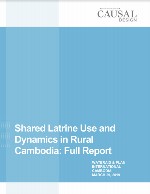Shared Latrine Use and dynamics in Rural Cambodia: Full Report
 |
rapport Mar 2019 ; 75 pages
Ed. Plan International - London WSSCC - Genève WaterAid - London
Téléchargeable sous format: PdF
Téléchargeable chez l'éditeur
Résumé:
Les résultats d'un projet de recherche qualitative axé sur une meilleure compréhension de l'utilisation partagée des latrines - la pratique de deux ménages ou plus partageant régulièrement une latrine - dans des communautés rurales du Cambodge sans défécation en plein air (ODF). Abstract:
Findings from a qualitative research project focused on better
understanding shared latrine use — the practice of two or more households
sharing a latrine on a regular basis — in open defecation free (ODF)
communities in rural Cambodia
Contents:
TABLE OF CONTENTS
ACRONYMS
EXECUTIVE SUMMARY
1.0 INTRODUCTION
1.1 Description of research
1.2 Research questions
1.3 This report
2.0 BACKGROUND AND CONTEXT
2.1 Sanitation and health
2.2 Commitments and action to improve rural sanitation
2.3 Shared latrine use
2.4 Shared latrine research, classifications and debate
3.0 METHODS AND EXECUTION
3.1 Overview
3.2 Sampling
3.3 Data collection methods
3.4 Data analysis and interpretation methods
FINDINGS AND INTERPRETATION
4.0 LATRINE SHARING: PREVALENCE AND PRACTICE
Key insights
4.1 How many households in target villages are sharing one latrine?
4.2 How many households are sharing one latrine?
4.3 How many people (users) are sharing one latrine?
5.0 CHARACTERISTICS AND RELATIONSHIPS
Key insights
5.1 What is the relationship between latrine hosts and sharers?
6.0 SHARING DURATION AND MODELS
Key insights
6.1 How long have households been sharing a latrine?
6.2 Was sharing planned? How did sharing come about?
7.0 FACILITATING FACTORS
Key insights
7.1 Why are households sharing a latrine?
8.0 LATRINE TYPE AND QUALITY, WASTE STORAGE AND DISPOSAL
Key insights
8.1 What type of latrines are being shared? What is their quality?
9.0 LATRINE ACCESS AND USE
Key insights
9.1 Who can access the latrine, and when?
9.2 Who is using the latrine, and when?
10.0 ROLES AND RESPONSIBILTIES: CONSTRUCTION, MAINTENANCE AND CLEANING
Key insights
10.1 How is sharing structured and managed?
Who built the latrine? Who contributed to labour and cost?
11.0 BENEFITS AND CHALLENGES
Key insights
11.1 What are the benefits of sharing a latrine?
No benefits
Health
Supporting another household to use a latrine
Health + Supporting another household to use a latrine
Saving money
11.2 What are the challenges of sharing a latrine?
Difficulty accessing the latrine when other people are using it
11.3 What would be the benefits of having a latrine for one household only? Why would hosts and sharers
like their own latrine?
12.0 SATISFACTION
Key insights
12.1 How satisfied are hosts and sharers with the latrine sharing arrangement? What appears to influence
satisfaction levels?
13.0 FUTURE INTENT
Key insights
13.1 What are the future intentions of households who are currently sharing a latrine? Do households plan
to continue sharing? How long do they anticipate sharing? What steps are they taking to do so? What
barriers are they facing?
14.0 INSIGHTS AND IMPLICATIONS
15.0 REFERENCES
16.0 APPENDICES
Appendix 1 - Village selection criteria
Appendix 2 - Data analysis methods
Appendix 3 - Supplementary heat maps
Mots clefs: |
assainissement autonome (CI) (DT) (OP) (ope) , rural (CI) (DT) (OP) (ope) |
Pays concerné: |
Editeurs/Diffuseurs: |
|
Plan International - London - Royaume Uni |
WSSCC
-
Water Supply and Sanitation Collaborative Council - Genève - Suisse |
WaterAid - London - Royaume Uni |
En cas de lien brisé, nous le mentionner à communication@pseau.org